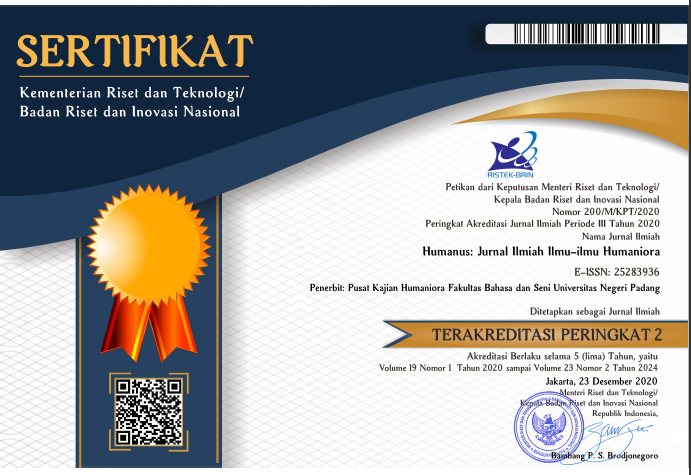UNDERSTANDING INDIGO THROUGH NOVEL GERBANG DIALOG DANUR BY RISA SARASWATI: A Study of Psychology Literary
 ), Emzir Emzir(2), Ninuk Lustyantie(3),
), Emzir Emzir(2), Ninuk Lustyantie(3), (1) Applied Linguistics, Postgraduate of Universitas Negeri Jakarta, Jakarta
(2) Applied Linguistics, Postgraduate of Universitas Negeri Jakarta, Jakarta
(3) Language Education, Postgraduate of Universitas Negeri Jakarta, Jakarta
 Corresponding Author
Corresponding Author
Copyright (c) 2018 Humanus
DOI : https://doi.org/10.24036/humanus.v17i1.8682
Full Text:
 Language : en
Language : en
Abstract
The objective of this research is to acquire deep understanding about Indigo through novel, Gerbang Dialog Danur’s novel by Risa Saraswati. Danur means of water that comes out from the rotten corpse. This qualitative research was conducted using content analysis method. This research was analyzed through structural literary approach and psychology literary approach. The data were collected through documents, and data observations about Indigo in Gerbang Dialog Danur’s novel by Risa Saraswati. The result of this research revealed that abundance of Indigo and lack of Indigo were founded and described in Gerbang Dialog Danur’s novel by Risa Saraswati. Those results lead to implication that Indonesian literature educator can use Gerbang Dialog Danur’s novel by Risa Saraswati directly in the teaching of literature studies, especially for psychology literary. The findings lead to recommendation to Indonesian literature educator, literature researcher, novel reader, parents, and everyone generally.
Keyword: Indigo children, novel, literature, psychology, teaching of literature
MEMAHAMI INDIGO MELALUI NOVELGERBANG DIALOG DANUR KARYA RISA SARASWATI: Kajian Psikologi Sastra
Abstrak
Tujuan penelitian ini adalah untuk memperoleh pemahaman mendalam tentang Indigo melalui novel, yakni novel Gerbang Dialog Danur karya Risa Saraswati. Danur berarti air yang keluar dari mayat yang busuk. Penelitian kualitatif ini dilakukan dengan menggunakan metode analisis isi. Analisis penelitian dilakukan pendekatan psikologi sastra. Data dikumpulkan melalui studi pustaka, dan observasi data tentang Indigo dalam novel Gerbang Dialog Danur karya Risa Saraswati. Hasil penelitian menunjukkan bahwa kelebihan Indigo dan kekurangan Indigo ditemukan serta digambarkan dalam novel Gerbang Dialog Danur karya Risa Saraswati. Hasil penelitian ini dapat diimplikasikan oleh pengajar sastra Indonesia, yakni dengan menggunakan novel Gerbang Dialog Danur karya Risa Saraswati secara langsung pada proses pengajaran. Hasil penelitian ini direkomendasikan untuk para pengajar sastra Indonesia, pembaca novel, peneliti sastra, para orang tua, dan setiap orang pada umumnya.
Kata kunci: anak Indigo, novel, sastra, psikologi, pengajaran sastra
Keywords
References
Ackerman, C. M. (1997). Identifying gifted adolescents using personality characteristics: Dabrowski’s overexcitabilities. Roeper Review, 19(4), 229–236. http://doi.org/10.1080/02783199709553835
Alvarado, C. S. (2012). Explorations of the features of out-of-body experiences: an overview and critique of the work of robert crookall. Journal of The Society for Psychical Research, 76(907), 68.
Asri, Y., Zulfadli, & Ismail Nst, M. (2016). Humanity degradation in the novels written by Minangkabau ethnics. Humanus: Jurnal-Jurnal Ilmu Humaniora, 15(2), 216–225.
Bagnol, L., Alexander, J., Ewing, H., & Chu, D. (2011). Indigos in hawai’i: a phenomenological study of the experience of growing up with spiritual intelligence. Pacific Health Dialog, 17(1), 83–98.
Carroll, L., & Tober, J. (2006). The indigo children. Jakarta: Bhuana Ilmu Populer.
Emzir, E., & Rohman, S. (2015). Teori dan pengajaran sastra. Jakarta: RajaGrafindo Persada.
Endraswara, S. (2008a). Metode penelitian sastra: teori, langkah, dan penerapannya. Yogyakarta: MedPress.
Endraswara, S. (2008b). Metodologi penelitian sastra: epistemologi, model, teori, dan aplikasi (p. 189). Yogyakarta: MedPress.
Gnanasekaran, R. (2014). Psychological interpretation of the novel the stranger by Camus. International Journal of English Literature and Culture, 2(6), 85.
Kesner, J. E. (2005). Gifted children’s relationships with teachers. International Education Journal, 6(2), 218–219.
Lench, H. C., Levine, L. J., & Whalen, C. K. (2013). Exasperating or exceptional? parents interpretations of their child’s ADHD behavior. Journal of Attention Disorder, 17(141), 142.
Liasna, T., & Ansari, K. (2016). Gender perspective in the novels padang bulan and cinta di dalam gelas by andrea hirata: a study and feminism literary criticism and its relevance as the literature reading materials for high schools. Humanus: Jurnal-Jurnal Ilmu Humaniora, 15(2), 207–215.
Minderop, A. (2010). Psikologi sastra: Karya sastra, metode, teori, dan contoh kasus. Jakarta: Yayasan Obor Indonesia.
Lončar-Vynović, M. (2013). Stream of consciousness technique and modern novel: psychological and methodological perspectives on language learning. IOSR Journal of Research and Method in Education, 2(2), 69.
Murdock-Smith, J. (2013). Understanding the social and emotional needs of gifted children. Rivier Academic Journal, 9(2), 1.
Ningrum, R. K., Waluyo, H. J., & Winarni, R. (2017). Representation of Japanese post-colonial experience in the year of 1942-1945 based on Pramoedya Ananta Toer’s novel “Perburuan.” Humanus: Jurnal-Jurnal Ilmu Humaniora, 16(1), 105–117.
Noermanzah. (2017). Plot in a collection of short stories “Sakinah bersamamu” works of Asma Nadia with feminimism analysis. Humanus: Jurnal-Jurnal Ilmu Humaniora, 16(1), 27–40.
Priyal, V. V., & Ramkumar, N. (2014). Comparative study on individual’s performance orientation and their aura life color. International Journal of Yoga-Philosophy, Psychology, and Parapsyhology, 2(2), 37.
Puguh, O. (2012). Buku lengkap tentang anak indigo. Yogyakarta: FlashBooks.
Putri, D. (2016). The shift of Minangkabau cultural values in the novel Presiden by wisran hadi (a genetic structuralism approach). Humanus: Jurnal-Jurnal Ilmu Humaniora, 15(2), 120–130.
Rosenshein, J. B. (2013). Parenting the highly sensitive child: A guide for parents and caregivers of ADHD, indigo and highly sensitive children. Bloomington: Balboa Press.
Saraswati, R. Gerbang Dialog Danur. Jakarta: Bukune, 2016.
Slavin, R. E. (2011). Psikologi pendidikan: Teori dan praktik. Edisi kesembilan jilid 2. Jakarta: Indeks.
Soecipto, N. A. (2011). Rahasia besar anak indigo: Dilengkapi mengenali indera manusia. Yogyakarta: IN AzNa Books.
Sundari, Z. A. (2017). Tembus 1 juta penonton, film Danur dapat rekor MURI. Retrieved May 10, 2017, from http://showbiz.liputan6.com/read/2912236/tembus-1-juta-penonton-film-danur-dapat-rekor-muri
Wellek, R. W., & Warren, A. (2014). Teori kesusastraan. Jakarta: Gramedia Pustaka Utama.
Yong, Y. M., & Arip, M. A. B. M. (2015). Development of indigo check list: the concern of malaysian society for needs of indigo children. International Journal of Education and Research, 3(10), 24.
 Article Metrics
Article Metrics
 Abstract Views : 2543 times
Abstract Views : 2543 times
 PDF Downloaded : 683 times
PDF Downloaded : 683 times
Refbacks
- There are currently no refbacks.
Copyright (c) 2018 Humanus

This work is licensed under a Creative Commons Attribution-NonCommercial 4.0 International License.










